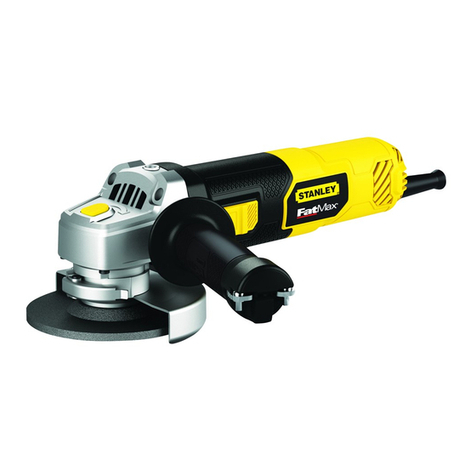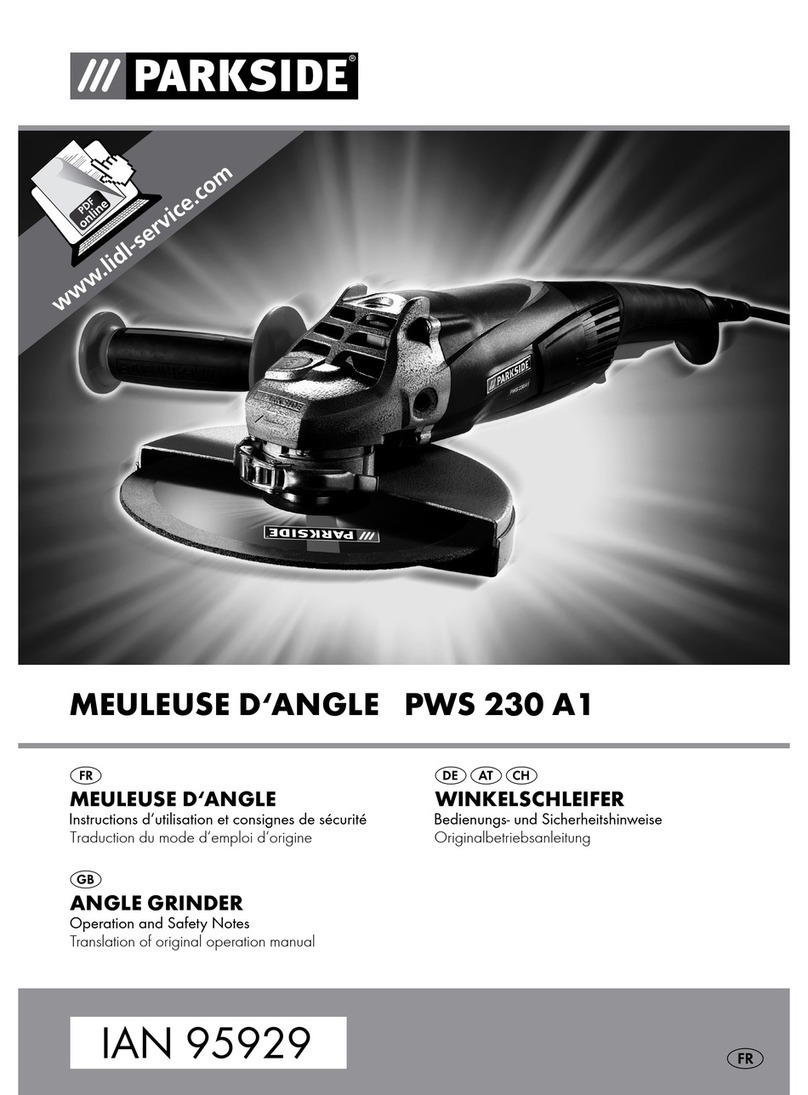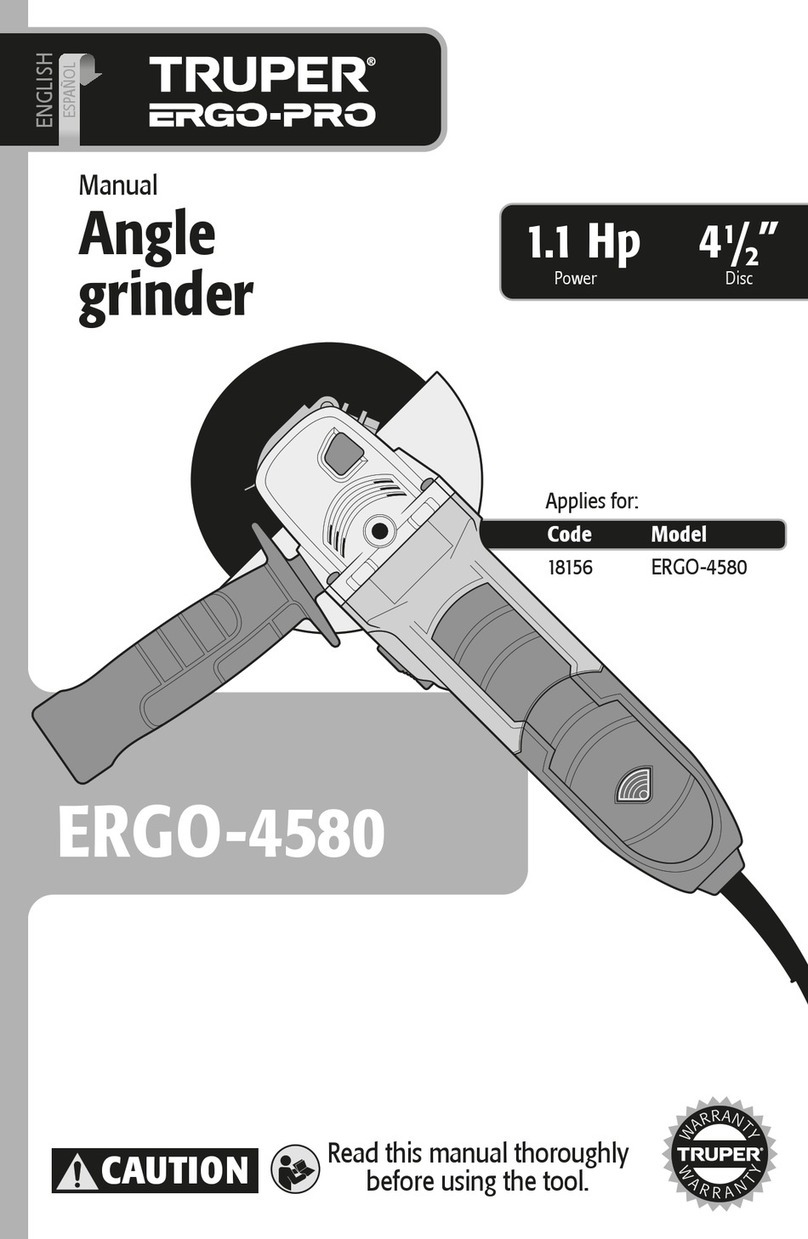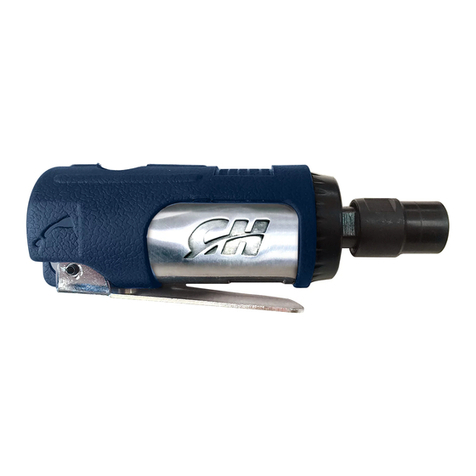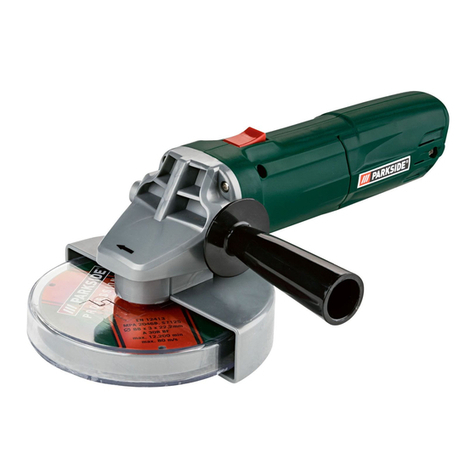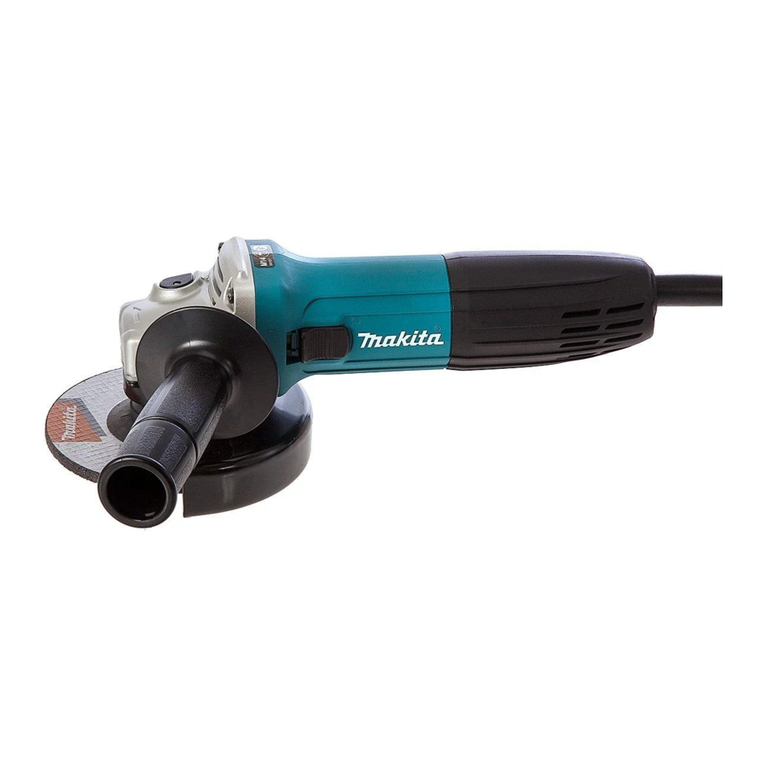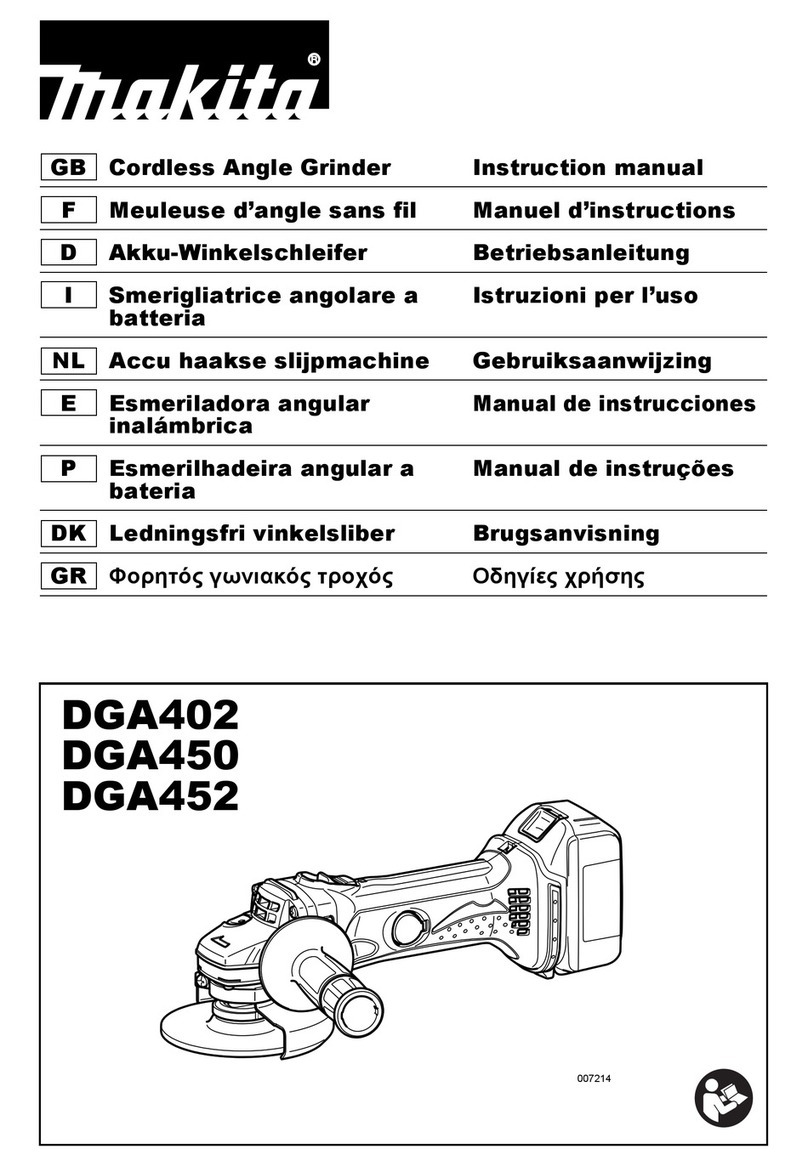TECNOMAGNETE QX Series Instructions for use

ITALIANOENGLISH
FRANÇAISDEUTSCH
ESPAÑOL ITALIANOENGLISH
FRANÇAISDEUTSCH
ESPAÑOL
SVENSKA
SISTEMI MAGNETICI ELETTROPERMANENTI
Divisione ancoraggio macchine utensili - serie rettifica e fresatura
PERMANENT-ELECTRO MAGNETIC SYSTEMS
Clamping Tool Machines Division - Systems for grinding and milling operations
SYSTÈMES MAGNÉTIQUES ÉLECTROPERMANENTS
Section serrage machines-outils - série rectification et fraisage
ELEKTROPERMANENTE MAGNETSYSTEME
Abteilung Verankerung von Werkzeugmaschinen - Serie Schleifen und Fräsen
SISTEMAS MAGNÉTICOS ELECTROPERMANENTES
División anclaje sobre máquinas herramienta - serie rectificado y fresado
ELEKTROPERMANENTA MAGNETSYSTEM
Avdelning för fästanordningar till verktygsmaskiner - serie för finslipning och fräsning
Manuale uso e manutenzione
Instruction and maintenance manual
Manuel d’utilisation et d’entretien
Betriebs- und Wartungsanleitung
Manual de uso y mantenimiento
Drift- och underhållsmanual
Nr. 50 100 7816
MILL TEC

41
Instruction and maintenance manual
ENGLISH
CONTENTS
1 GENERAL NOTES............................... 42
1.1 Overview of the company........................ 42
1.2 Importance of the manual........................ 43
1.3 Storing the manual................................... 43
1.4 Conventions............................................. 43
1.5 Denition of symbols ............................... 43
1.6 Personnel responsible for the
operation of the system ........................... 43
1.7 Trained personnel .................................... 44
1.8 Individual protection means..................... 44
1.9 General safety precautions...................... 44
1.10 Behavior during emergency situations .... 45
1.11 Improper or non permitted use................ 45
1.12 Nameplate................................................ 45
2 TRANSPORTATION AND
HANDLING............................................ 46
2.1 Receipt..................................................... 46
2.2 Handling................................................... 46
2.3 Transportation.......................................... 46
2.4 Storage .................................................... 47
3 DESCRIPTION OF THE SYSTEM ... 47
3.1 Advantages.............................................. 47
3.2 Main principles concerning the
clamping of parts..................................... 48
3.3 Factors that inuence magnetic forces ... 48
4 AVAILABLE MODELS......................... 53
4.1 Magnetic chucks with square poles ........ 53
4.2 Magnetic chucks with parallel poles........ 56
4.3 Magnetic chucks with round poles.......... 58
5 GENERAL DESCRIPTION OF
THE SYSTEM ....................................... 59
5.1 Millers....................................................... 59
5.2 Grinders ................................................... 59
6 INSTALLATION .................................... 60
6.1 Warnings ................................................. 60
6.2 Preparation .............................................. 60
6.3 Mechanical installation ............................ 60
6.4 Electrical connections.............................. 60
6.5 Useful technical information .................... 61
7 ASSESSMENT OF RESIDUAL
RISKS .................................................... 61
Page
8 ORDINARY USE OF THE
SYSTEM................................................. 62
8.1 Clamping force ......................................... 62
8.2 Cutting force............................................. 62
8.3 Positioning the parts onto extensions...... 63
8.4 How to calculate the clamping force........ 65
8.5 Example of how to calculate the
clamping force of a magnetic chuck........ 65
8.6 Instructions on how to clamp parts
for traditional machining operations......... 66
8.7 Machining examples ................................ 68
9 MAINTENANCE ................................... 72
9.1 Introduction .............................................. 72
9.2 Safety standards during maintenance...... 72
9.3 Daily maintenance .................................... 73
9.4 Weekly maintenance ................................ 73
9.5 Monthly maintenance ............................... 73
9.6 Maintenance to be carried out
every six months ...................................... 73
9.7 Extraordinary maintenance....................... 73
9.8 Information on extraordinary
reparations and maintenance .................. 73
10 TROUBLESHOOTING AND
CORRECTIVE ACTIONS.................... 74
11 SPARE PARTS...................................... 74
12 DECOMMISSIONING AND
DISPOSAL ............................................. 74
12.1 Decommissioning..................................... 74
12.2 Dismantling............................................... 74
13 WARRANTY AND TECHNICAL
SUPPORT .............................................. 75
13.1 Warranty terms and conditions ................ 75
13.2 Warranty invalidity .................................... 75
14 TECNOMAGNETE SUPPORT
CENTRES ............................................. 76
15 ATTACHMENTS ................................... 77
15.1 Declaration of conformity ......................... 77
Number: 03-11
Issue: 03-10

42 Instruction and maintenance manual
ENGLISH
1GENERAL NOTES &
Thank you for purchasing one of the many products
manufactured by TECNOMAGNETE S.p.A.
This manual is designed to help you become familiar
with your new system and must therefore be care-
fully read and followed.
Should you require any further information regarding
the system, please contact the TECNOMAGNETE
service department.
The descriptions and illustrations provided in this
manual are for reference only.
While guaranteeing the basic features specied for
each type of equipment, TECNOMAGNETE S.p.A.
reserves the right to change at any time and without
notice the parts, details and accessories that it
deems necessary for engineering or commercial rea-
sons or in order to improve the product. The neces-
sary updates, if required, shall be supplied as attach-
ments.
This manual is property of TECNOMAGNETE S.p.A.
and cannot be copied (in part or in whole) or made
available to third parties without the written consent
of the manufacturer. Should the products be amend-
ed and/or updated, upon authorization of TEC-
NOMAGNETE S.p.A., the manufacturer shall inte-
grate the existing manual by providing the text
explaining the use of the modied/integrated com-
ponent along with a description of potential residual
risks.
1.1 Overview of the company
TECNOMAGNETE started its activities in 1972 as
manufacturer of permanent-electro magnetic sys-
tems designed to ensure power, exibility and maxi-
mum safety. Its state-of-the-art technologies and the
patents developed over the years have enabled the
company to become a leading supplier in several
international markets.
The permanent-electro magnetic systems manufac-
tured by TECNOMAGNETE are able to produce all
the magnetic force required both to clamp and lift
parts, thus eliminating the need of using electric
power during machining.
Its main elds of activity include:
CLAMPING SYSTEMS FOR TOOL MACHINES
•
Grinders
•
Millers
•
Lathes
•
Systems for the machining of rails
MOLDING SYSTEMS
•
Systems designed to clamp the molds onto
presses
LIFTING SYSTEMS FOR LIGHT LOADS
•
Manual lifters
•
Battery operated lifters
LIFTING SYSTEMS FOR HEAVY LOADS
•
Magnetic lifters
•
Fixed crossbeams to support magnetic mod-
ules
•
Telescopic crossbeams to support magnetic
modules
TECNOMAGNETE has installed approximately
50,000 units in over twenty years, thanks mainly to
its wide-ranging offer, its exibility to meet custom-
ers’ requirements and its efcient post-sales serv-
ice.

43
Instruction and maintenance manual
ENGLISH
1.2 Importance of the manual
A copy of this manual must always be made availa-
ble to the operators responsible for the installation,
operation and maintenance of the system in order to
allow them to carry out all the required operations in
compliance with the instructions provided in the
manual.
A full compliance with the instructions provided in
this manual is an essential requirement to be able to
correctly use the equipment and ensure the safety of
operators and other people.
The manual forms integral part of the system. There-
fore, all reproduction and divulgation rights related to
the manual or its attachments are reserved.
The manual must always be transferred to the new
owner of the system if the latter is sold.
1.3 Storing the manual
It is severely forbidden to remove parts, tear pages
or alter this manual.
The manual should always be carefully preserved so
that it is not damaged.
Always protect the manual from excessive humidity
and heat and store it in a location where it can be
easily accessed by operators in case of need.
1.4 Conventions
To simplify consultation, the manual has been divid-
ed into the following hierarchical order so that each
phase is described in detail:
1Section 1 of the manual
1.1 Chapter 1 of Section 1 of the manual
1.1.1 Paragraph 1 of Chapter 1 of Section 1 of
the manual
1.1.1.1 Subparagraph 1 of paragraph 1 of Chap-
ter 1 of Section 1 of the manual
Some chapters and/or sections contain bulleted lists
to allow operators to follow the operation described
step by step.
Parts that require specic attention are highlighted
with symbols.
Units of measure, including decimal values, have
been indicated using the international system of
units.
1.5 Definition of symbols
All information related to safety is highlighted in
bold.
All warnings that draw the attention of operators on
operations that may be hazardous in terms of safety
or health or that may cause physical injuries, if the
applicable instructions are not followed, are high-
lighted in bold and marked with the following sym-
bol:
All warnings related to operations that have to be
carried out by skilled and qualied personnel are
highlighted in bold and marked with the following
symbol:
1.6 Personnel responsible for the
operation of the system
Some operations, as stated in this manual, can only
be performed by qualied and skilled personnel. The
qualication level is described by means of the fol-
lowing standard denitions:
•
Qualied personnel is personnel with specic
technical knowledge and/or the experience nec-
essary to avoid potential risks originating from
power and/or mechanical components (engineers
and technicians).
•
Trained staff is personnel that operates following
the instructions and/or under the supervision of
qualied personnel, who is responsible for verify-
ing that they are not exposed to potential hazards
resulting from the contact with power and/or me-
chanical moving parts (personnel responsible for
operation and maintenance). .
•
Before using the system, users shall always have
to verify with authorized personnel that:
1. All personnel has received a copy, has read and
understood the content of the instruction man-
ual
2. All personnel has agreed to follow the instruc-
tions provided

44 Instruction and maintenance manual
ENGLISH
1.7 Trained personnel
•
OPERATORS: workers who, after receiving the
necessary instructions, have been authorized by
the owner to operate the system. Workers with
this qualication must be thoroughly familiar with
the content of this manual.
•
PERSONNEL RESPONSIBLE FOR HANDLING
OPERATIONS: personnel working in this role must
possess specic skills (that must sometimes be
acquired by following special training courses, if
required by current laws) and be familiar with the
operation of lifting equipment and methods, types
of slinging and procedures to safely handle loads.
This qualication implies having a perfect knowl-
edge and full familiarity with the content of section
2.2.
•
MECHANICAL MAINTENANCE TECHNICIAN:
these workers must be thoroughly familiar with
installation, adjustment, maintenance, cleaning
and/or reparation procedures. This qualication
implies having a perfect knowledge and full fa-
miliarity with the content of this manual.
•
ELECTRIC MAINTENANCE TECHNICIAN (ref.
EN60204 paragraph 3.45): this qualication is as-
signed to all personnel specically trained to per-
form operation on electric components, which in-
clude connections, adjustments, maintenance
and/or reparations, and to personnel who is qual-
ied to perform operations inside electric cubicles
and boards. This qualication implies having a
perfect knowledge and full familiarity with the
content of this manual.
1.8 Individual protection means
All personnel listed above must wear suitable
clothing to protect them from potential industrial
accidents.
In particular, personnel must always wear indus-
trial shoes along with ear protection, helmets and
goggles, if required.
All personnel should refrain from wearing loose
clothing that could get tangled with moving com-
ponents.
1.9 General safety precautions
The instructions and recommendations provided
below comply with current safety regulations and
imply the obligation of complying with applicable
provisions.
TECNOMAGNETE S.p.A. shall not be responsible
for damages caused to people or equipment
originating from the failure to follow applicable
safety provisions and to comply with the instruc-
tions given below.
All operators are therefore expected to follow the
instructions below and to thoroughly comply with
the safety procedures concerning the installation
and use of the equipment applicable in the coun-
try in which the system is used.
All ordinary and extraordinary maintenance op-
erations must be performed when the system is
idle and after it has been disconnected from the
power supply, if possible.
To prevent the system from being accidentally
started during maintenance operations, it is al-
ways advisable to place onto the control panel a
sign with the following warning:
ATTENTION! CONTROL DISABLED DUE
TO MAINTENANCE
Before connecting the power cable to the termi-
nal box on the main board, it is essential to verify
that the line voltage complies with the one shown
on the nameplate of the board.
All transportation, installation, ordinary and ex-
traordinary maintenance operations performed
on the system must be carried out only by per-
sonnel with the qualifications stated in paragraph
1.6.
The system can be used only for the applications
specified in operating instructions and only in
combination with the equipment and compo-
nents recommended by TECNOMAGNETE S.p.A.

45
Instruction and maintenance manual
ENGLISH
1.10 Behavior during emergency
situations
In the event of emergency, it is always advisable
to follow the procedures outlined in the operation
and maintenance manual of the machine on
which the system is installed.
In the event of fire, always use the extinguishing
means provided being careful not to use water to
extinguish fires on electric parts.
1.11 Improper or non permitted use
The system is not designed to be used in explo-
sive environments.
An improper use may:
•
Cause injuries to personnel
•
Damage the system or other equipment
•
Reduce the reliability and performance of the
system
The system must always be used for the applica-
tions for which it has been designed and manu-
factured. Therefore, customers should:
•
Always use suitable working parameters
•
Carry out the required maintenance in accord-
ance with he instructions provided
•
Use appropriate materials
•
Comply with all the instructions provided
•
Safely and firmly fix the system and all its
parts
•
Contact TECNOMAGNETE S.p.A. in case of
doubt to determine whether a specific opera-
tion is permitted
The clamping of special materials, other than
those referred to in this manual, must be
preventively authorized in writing by the
TECNOMAGNETE S.p.A.
1.12 Nameplate
Magnetic chucks are fitted with a nameplate that
provides information on the manufacturer, in
compliance with current law requirements.
The nameplate should never be removed even if
the system is resold.
If the nameplate is damaged or has been
removed, it is necessary to contact
TECNOMAGNETE S.p.A. to order a duplicate.
Always quote the model printed on the
nameplate in all communications with
TECNOMAGNETE S.p.A.
Failure to comply with the above instructions
shall entitle TECNOMAGNETE S.p.A. to disclaim
any responsibility for injuries to personnel and
damage to equipment, making the user fully re-
sponsible before competent authorities.

46 Instruction and maintenance manual
ENGLISH
2TRANSPORTATION
AND HANDLING
MILLERS and GRINDERS can be transported in
wooden crates and mounted onto a pallet to simplify
handling.
2.1 Receipt
All systems are carefully inspected before ship-
ping. Upon receipt, customers should verify that
the packaging and the material inside it has
not been damaged (unless otherwise instructed by
TECNOMAGNETE S.p.A.) in order to ensure that the
system has not been damaged during transport and
that the material supplied complies with order spec-
ications. Visible transport damages should be im-
mediately reported to TECNOMAGNETE S.p.A. and
the forwarding agent.
ATTENTION
All faults and defects must be reported within ten
days from receiving the goods.
2.2 Handling
ATTENTION
All personnel involved in handling loads should
wear protective gloves and shoes.
The customer will always have to verify that all
handling operations are carried out in accord-
ance with applicable safety requirements.
ATTENTION
When lifting or handling the system, always make
sure that the surrounding area is clear and free
from obstacles, and that the recommended safe-
ty distances are maintained, in order to prevent
causing injuries to people and animals or dam-
age to equipment present near the system.
The system is designed to be lifted and handled
with appropriate lifting equipment with charac-
teristics and capacity suitable for the weight to
be handled.
Handling operations must always be performed
very carefully in order to avoid potential impacts
that could damage the system parts and prevent
them from operating correctly.
When using fork lifters, always verify that speed
and inclinations are within recommended values.
Do not leave lifting equipment unattended when
the load is suspended.
ATTENTION
Always verify that the system is disconnected
from energy supplies and that all moving parts
are firmly fixed in place when transporting, han-
dling and storing the system.
ATTENTION
Do not handle lifting systems with electromag-
netic lifters.
ATTENTION
Read all the instructions on the packaging before
opening it.
Always keep the original packaging so that it can
be used to transport the system if needed.
2.3 Transportation
In order to transport the system, it is sometimes nec-
essary to disassemble some of its parts. These parts
will later be reassembled and reconnected during
the installation phase by the service technicians of
TECNOMAGNETE S.p.A. or of the customer under
the supervision of TECNOMAGNETE S.p.A person-
nel.
The system should always be transported within the
following environmental limits: temperature ranging
from –10°C to +55°C, with temperature increase up
to 70°C for a maximum of 24 hours.
If the system requires the use of specic transporta-
tion means (by sea or air), special provisions shall

47
Instruction and maintenance manual
ENGLISH
have to be adopted in order to protect it from dam-
ages caused by potential impacts. In order to protect
the system from atmospheric agents, lubricate it
with anti-corrosion oils and place hygroscopic salts
in the box. All parts that cannot be permanently xed
in place must be removed.
2.4 Storage
Before removing the system from service or storing it
for long periods of time, always thoroughly clean it in
order to remove machining scraps and protect all
visible metal parts with protective oils or greases to
prevent the surfaces from oxidizing.
Disconnect the controller from the magnetic chuck
and from the power supply.
It is generally advisable to cover the system with a
waterproof sheet and store it in dry and safe place.
The temperature of the storage area should range
between 0°C (32°F) and 55°C (131°F).
Relative humidity should be between 30% and 90%,
non condensing.
The atmosphere should be clean, free from acids,
corrosive gases, salts, etc.
Always restart the system in accordance with the in-
structions provided in Chapter 6.
3DESCRIPTION OF
THE SYSTEM
3.1 Advantages
The best possible clamping conditions that a tooling
machine can offer are as follows:
1) Firmly x the part that has to be machined
2) Verify that the tool is able to access the surfaces
that have to be machined.
Magnetic clamping systems offer the advantage of
combining the best of these two operating condi-
tions:
1) The clamping forces generated by magnetic sys-
tems are evenly distributed along all contact sur-
faces, in addition to having an intrinsic strength.
2) The part that has to be machined is clamped only
along the contact surface, so that the remaining
surfaces can be accessed by the tool.
The substantial difference in distribution of the
clamping forces account for the greater perform-
ances offered by magnetic systems as compared to
traditional mechanical systems. Some of the main
advantages include:
a) The high clamping force of magnetic systems is
consistently distributed on all surface of the part
to clamp. This can be particularly useful when
clamping sensitive pars like those with a small
thickness or that tend to easily deform.
b) The working principle of magnetic systems offers
the unparalleled advantage of signicantly reduc-
ing vibrations created by machining. This means
that it is possible to remove materials at greater
speed and perform more accurate machining op-
erations.
European standards concerning the safety of work plac-
es and electromagnetic compatibility clearly emphasize
the superiority of permanent-electro magnetic systems
as compared to electromagnetic ones, because they
do not require a continuous source of external energy,
except for the clamping and release phases, and do not
affect the operation of other equipment as they do not
return any form of energy to the network.
Magnetic clamping systems ensure a continuous air
ow. The system is not dependant on external energy
sources while the tool machining is in progress, which
means that if a power failure occurs, the clamping forc-
es are not affected and are therefore able to continue
clamping the part.

48 Instruction and maintenance manual
ENGLISH
3.2 Main principles concerning the
clamping of parts
The magnetic force lines close between the northern
and southern pole of the magnetic chuck.
This ow can be used to attract and clamp ferrous
parts. A steel part exposed to a magnetic eld is at-
tracted by the opposed polarity of the eld towards
the magnet, until contact is achieved.
Steel
The ow produced by the steel varies according to
the material it contains, its dimensions, the level of
contact achieved between the part to clamp and the
magnetic chuck, and the easiness with which the
ow passes through the steel.
3.3 Factors that influence magnetic
forces
The amount of magnetic ow applied to the part is
the factor that most inuences the clamping force.
To achieve an optimum clamping force, it is neces-
sary to apply the greatest possible magnetic ow
to the part being machined. If the part has a simple
design, it is sufcient to correctly position it on the
northern and southern poles of the magnetic chuck.
The clamping force is proportional to:
1) The square of the density of the magnetic ow
present on the surface that is in contact with the
part
2) The area of the part that is in contact with the
magnetic chuck up to maximum saturation point.
Clamping force daN/cm2
Flow density
Surface
Clamping force daN/cm2
Doubling the contact area means doubling the
clamping force. A 10% reduction in the ow density
reduces by 19% the clamping force. If the ow den-
sity is halved, the clamping force is reduced by 75%.
The ow density tends to reduce when the ow en-
counters a magnetic resistance (reluctance). A typi-
cal example of this type of situation is represented
by air gaps (where an air gap represents the average
contact distance between the part to machine and
the magnetic chuck) and the elements that form the
material of the part being clamped. The main factors
that inuence the ow density and clamping force
applied to a part of any dimension are described
below.

49
Instruction and maintenance manual
ENGLISH
3.3.1 Contact surface
The condition that provides the highest resistance to
the forces generated during machining is achieved
when air gaps are reduced to a minimum and there-
fore the contact between the surfaces is continuous.
The worst results are achieved with an air gap and a
minimum contact.
100% = Optimum clamping
60% = Very good clamping
40% = Satisfactory for some operations
20% = Sometimes sufcient for light grinding
operations
Contact
surface
Contact surface
Surface to machine
3.3.2 Superficial finish
The machining operation is also inuenced by the
supercial roughness of the part to machine. A good
contact surface with the magnetic chuck signicant-
ly reduces air gaps and thus ensures a consistent
clamping force.
100% = Grinding
90 ÷ 80% = Fine milling
80 ÷ 70% = Milling
70 ÷ 60% = Not machined
100%
90% 90% 80% 80%
70% 70%
60%
Contact
surface
Grinding Fine milling Milling Not machined
3.3.3 Material used
Always check the material of the part that has to be
machined in order to verify that it is magnetically
conductible. The most conductive material is mild
steel. The following reduction factors apply to other
materials:
100% Mild steel
70 ÷ 80% Alloyed steel
50% Cast iron
20% Nickel
0% Non magnetic stainless steel, brass and
aluminum
3.3.4 Conditions of the part surface
Supercial heat treatments change the physical
structure of surfaces and consequently also inu-
ence their capacity of absorbing magnetic ows. An-
nealed materials provide higher performances. Tem-
pered materials are unable to satisfactorily absorb
the magnetic ow and tend to maintain a certain
degree of magnetism even after the chuck has been
disabled (DEMAG), to the point that it is sometimes
difcult to detach the part from the magnetic chuck.
Residual (or absorbed) magnetism can be removed
by using a demagnetizer.
3.3.5 Thickness of the part
The ow follows a semicircular path inside the part,
which originates from the center of the pole, moves
towards the magnetic chuck and reaches the center
of the subsequent one.
If the part is smaller than this radius, the part of
the ow that it is output may disperse and cannot
therefore be used to clamp the part. Consequently,
the resulting attraction will be smaller than the one
achieved when you machine a part with a thickness
that is able to absorb the whole ow.
1) Always check the thickness of the part to ma-
chine.
If the thickness is insufcient, you will notice resid-
ual magnetism on the surface opposite the contact
one, along with lower performances. The whole ow
output from the magnetically anchored part is dis-
persed.
The depth of the magnetic ow varies according to
the model of magnetic chuck.
However, as a general rule parts with a small thick-
ness require the use of poles with a smaller section.
The magnetic clamping section of a system with
square poles is equivalent to one fourth (1/4) of the
side of pole (if the part covers at least 4 poles ar-
ranged in alternate conguration, to the side of the
pole (if the part covers at least 2 poles in sequence)

50 Instruction and maintenance manual
ENGLISH
and to the smaller side of the pole (for systems for
parallel poles). The clamping force for smaller thick-
ness values is inversely proportional to the ratio
between the thickness (S) of the part and the theo-
retical magnetic clamping section (L), as described
above. Consequently, the ow reduction factor (Fr)
will be equivalent to (Fr) = S/L
N S N S N S
N S N S N S
Figure A
Figure B
Figure C
L = C;
S = L
L = 2 xC;
S = 0,5 x C
L = 3
x
C;
S = 0,35
x
C

51
Instruction and maintenance manual
ENGLISH
3.3.6 Magnetic force
This manual applies to two types of clamping sys-
tems:
•
Systems for milling operations
•
Systems for grinding operations.
The circuits of these two types of systems are obvi-
ously different due to the fact that the forces used
differ and are generally higher for milling operations.
The default circuit of systems for milling operations
comprises a reversible magnet, placed below the
ow conductor (pole), and a static magnet that sur-
rounds the pole. When the reversible magnet works
in parallel with the static one, the two forces are
combined.
The default circuit of systems for grinding operations
includes a single magnet that is placed under the
ow conductor.
Consequently, the clamping forces and enabling/
disabling principle are different.
On systems for milling operations, the polarity of the
magnet under the pole is inverted by the solenoid
that surrounds it, while on systems for grinding op-
erations, the magnet is magnetized and demagnet-
ized by the solenoid.
In the circuit of systems for milling operations all
north and south poles are alternated. Consequently,
the crown (or frame) is neutral and is therefore called
“neutral crown”. On systems for grinding operations
(with one magnet, all poles have the same polarity
(north by default) and the magnet is closed by the
frame (which is called “active crown”).
Consequently, the forces involved are signicantly
different because the amount of magnetic ow is
clearly much higher in systems for milling opera-
tions.
The magnetic clamping force is represented by
means of the following curves that have been calcu-
lated in the following operating conditions:
•
Part to clamp in mild steel
•
Thickness suitable to contain the magnetic ow
•
Consistent and level contact surface.
Figure D
Figure E
Figure F
L = 1,5 x C;
S = 0,7 x C
L = 2 x C;
S = 0,5 x C
L = 4
x
C;
S = 0,25
x
C

53
Instruction and maintenance manual
ENGLISH
4AVAILABLE MODELS
The permanent-electro magnetic systems for mill-
ing and grinding operations described in this manual
can be divided into the following categories:
MAGNETIC CHUCKS WITH SQUARE POLES
Series: QX and SQ/ST; HD; HP; CUBOTEC;
QX/HN; QG
MAGNETIC CHUCKS WITH PARALLEL POLES
Series: SGL; PRL; TFP1; TFP0; TPF; MDS
MAGNETIC CHUCKS WITH ROUND POLE
Series:
RPC; MILL TEC
4.1 Magnetic chucks with square poles
4.1.1 Series QX and SQ/ST
Models with a low density of poles that are particu-
larly suitable for medium and large magnetic chucks.
These models are constituted by magnetic sectors
formed by “islands” of poles, that produce a clamp-
ing force proportional to the dimensions of the parts
to machine. These models are particularly suitable to
machine medium and large parts.

54 Instruction and maintenance manual
ENGLISH
4.1.2 Series
QX, MILL TEC and SQ/HD
Systems with high density poles suitable for small/
medium magnetic chucks. These models have large
magnetic surfaces and can therefore be used to
clamp parts with small and medium dimensions.
4.1.3 Series QX and SQ/HP
These systems, which can be congured in version
ST or HD, offer the power required to machine parts
with discontinuous surfaces. They are ideal to rough
non machined or forged parts because of the com-
bination of a high clamping force and wide-ranging
magnetic eld.

55
Instruction and maintenance manual
ENGLISH
4.1.4 CUBOTEC
This system consists of a series of QX and SQ
blocks arranged in vertical single bloc units, in the
shape of shoulders and magnetic cubes. It is ide-
ally suited for horizontal machining centers and FMS
systems. The system provides a supporting surface
that can be fixed onto machine workbenches and a
second surface to support parts with large dimen-
sions and weights.
4.1.5 Series QX/HN, QXG and QG
These systems have a square pole, like models QX
and SQ, but are designed with a special technology
that allows them to be used with high speed grinders
and millers for the machining of alloyed steels.

56 Instruction and maintenance manual
ENGLISH
4.2 Magnetic chucks with parallel poles
4.2.1 Series SGL
Magnetic chucks for milling operations, based on
the same technology of QX and SQ, models, but
with poles arranged in a parallel conguration. These
systems are ideal to machine parts like proles, rails,
bulb plates, etc.
4.2.2 Series PRL
Magnetic chucks for grinding and milling operations,
based on the typical technologies of MILLERS and
GRINDERS, with poles arranged in a parallel cong-
uration. Even these chucks are specically designed
for the machining of parts, like models SGL, but re-
quire the integration of dedicated technologies when
used for grinding operations.
4.2.3 Series TFP1
Permanent-electro magnetic systems for GRINDING
operations, specically designed for high precision
grinding.
These systems have parallel poles and a magnetic
surface entirely coated in metal.

57
Instruction and maintenance manual
ENGLISH
4.2.4 Series TFP0
Permanent-electro magnetic systems for GRINDING
operations, specically designed for high precision
grinding. These systems differ from model TFP1 be-
cause the magnetic surface is coated with a mix of
steel/resin.
4.2.5 Series TPF
Permanent-electro magnetic systems for GRINDING
operations, specically designed for high precision
grinding. These systems have the same character-
istics of model TFP1, but have a higher polar pitch
that allows the machining of parts with a small thick-
ness.

58 Instruction and maintenance manual
ENGLISH
4.2.6 Series MDS
Permanent-electro magnetic systems that have the
same technology and conguration of model TPF,
which is also applied to EDM systems.
4.3 Magnetic chucks with round poles
4.3.1 RPC
Permanent-electro magnetic systems for GRINDING
operations, specically designed for high precision
grinding of parts with medium dimensions and thick-
ness. These systems can be tted with a shapeable
over-plate fully coated in metal. Poles are arranged
in a circular conguration.

59
Instruction and maintenance manual
ENGLISH
5GENERAL DESCRIPTION
OF THE SYSTEM
5.1 Systems for milling operations
The system described in the manual comprises:
•
One or two magnetic chucks
•
Accessories (xed and mobile polar extensions).
5.1.1 Accessories for milling
In order to be able to machine parts with small di-
mensions or discontinuous supporting surfaces,
it is possible to separately purchase the following
accessories, which include xed and mobile exten-
sions with stop:
•
Fixed extension
•
Mobile extension
•
Double xed extension
•
Fixed extension with stop
•
Round mobile extension
TECNOMAGNETE S.p.A. is also able to supply on
request special and custom accessories.
5.2 Systems for grinding operations
The system described in the manual comprises:
•
One or more magnetic chucks.
5.2.1 Accessories for grinding
To able to machine parts with shaped supporting
surfaces, it is possible to separately purchase sha-
peable over-plates that reproduce the polar pitch of
the chuck on which they are tted.
TECNOMAGNETE S.p.A. can however be contacted
at any time for specic requests or assistance.
Fixed extension Mobile extension
Double xed
extension
Fixed extension
with stop
Round mobile
extension

60 Instruction and maintenance manual
ENGLISH
6INSTALLATION
6.1 Warnings
Before tting the magnetic chuck onto the machine
for which it is designed, always perform the follow-
ing operations:
•
Verify that the system is installed so that it is pos-
sible to access all components for ordinary and
extraordinary maintenance purposes, remember-
ing to leave the required spaces (approximately 1
m along each side of the system).
•
Verify that the lighting of the site of installation
guarantees a perfect view of all the production
cycle from all four sides of the machine.
•
Verify that all the main chucks are perfectly aligned
using a spirit level and perform the required ad-
justments by inserting shims under the supporting
points.
The system is designed to work under the following
conditions:
Operating temperature: -10°C÷+80°C
(14°F÷176°F)
Humidity: <50% at 40°C (104°F)
6.2 Preparation
•
Clean all the parts with a clean and dry cloth in
order to remove the residuals of anti-corrosion
coating.
•
Verify that all the mobile parts are correctly posi-
tioned and aligned.
6.3 Mechanical installation
TECNOMAGNETE guarantees, for all the models
described in this manual, a parallelism tolerance
of +/- 0.05/1000 between the magnetic surface
and the resting one on the machine bench (or a
verticalness tolerance for CUBOTEC systems or
for systems used to form MAGNETIC SQUARES).
After completing installation, TECNOMAGNETE
advises to finish the magnetic surface with a
miller fitted with a scraping insert or a grinder.
Customers who decide to install directly the
magnetic system, must specifically refer to the
instructions provided in this manual. If additional
fixing holes are required, always remember to drill
them on the housing that encloses the magnetic
circuit. If necessary, it is also possible to drill on
these surfaces positioning and reference holes
for the parts to machine (the holes on the poles
are provided for this purpose). TECNOMAGNETE
S.p.A. can be contacted at any time for special
requirements concerning the areas that can be
drilled and machined.
The following tables provide the axial pre-charge
value Pand the corresponding torque values Mthat
have to be applied to the screws used to assemble
the chuck onto the tool machine. The values in the
table apply to screws with hex head type UNI 5737-
65 and to socket head screws type UNI 5931-67.
The friction coefcient was considered equivalent
to 0.14, which is the value that generally applies to
blackened and lubricated surfaces. The torque must
be applied gradually using dynamometric wrench-
es.
Threading Resistance class = 8.8
P daN M mdaN
M 12 x 1.75 3780 8.5
M 12 x 1.25 4130 9.6
M 14 x 2 5150 13.5
M 14 x 1.5 5600 14.3
M 16 x 2 7030 20.5
M 16 x 1.5 7480 21.4
M 18 x 2.5 8600 28.3
M 20 x 2.5 11000 40
M 20 x 1.5 12200 43.1
M 22 x 2.5 13600 53.2
M 22 x 1.5 14900 57.1
M 24 x 3 15800 69.1
M 24 x 2 17200 73.1
6.4 Electric connections
All wiring instructions are provided in the operation
and maintenance manual of the controller supplied
with the magnetic chuck. This manual therefore pro-
vides basic information only.
This manual suits for next models
14
Table of contents
Popular Grinder manuals by other brands
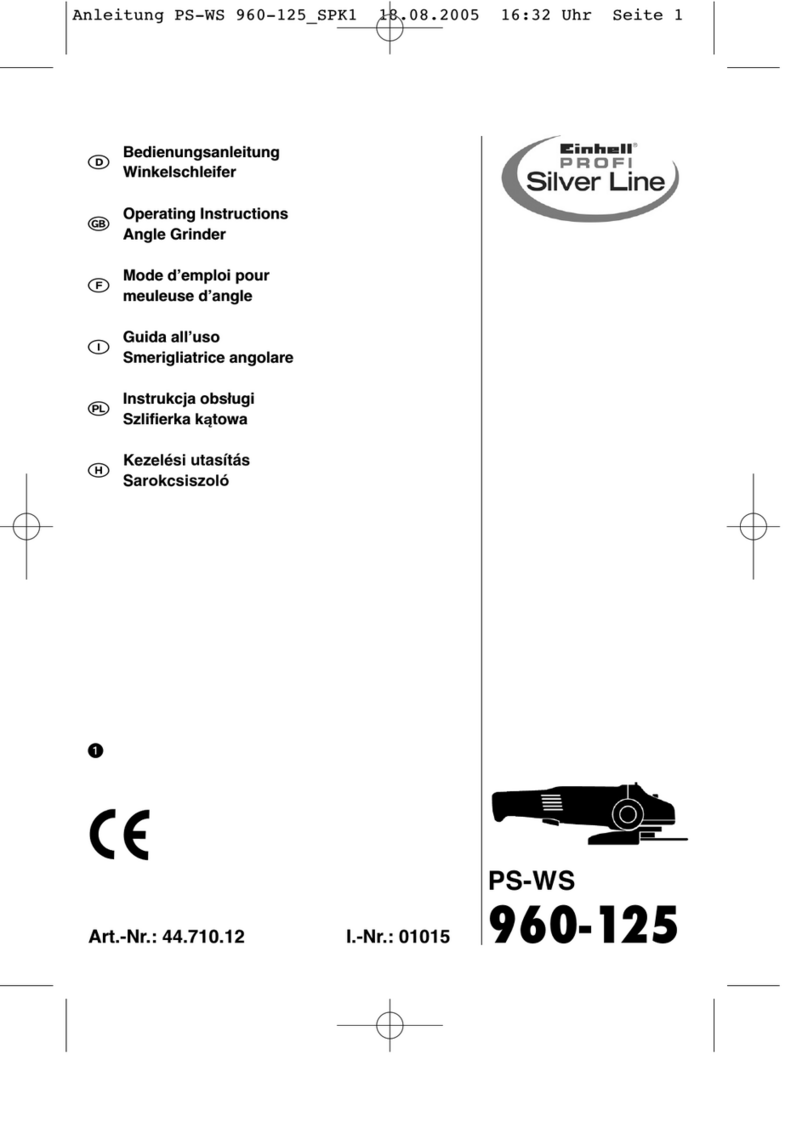
EINHELL PROFI
EINHELL PROFI Silver Line PS-WS 960-125 operating instructions
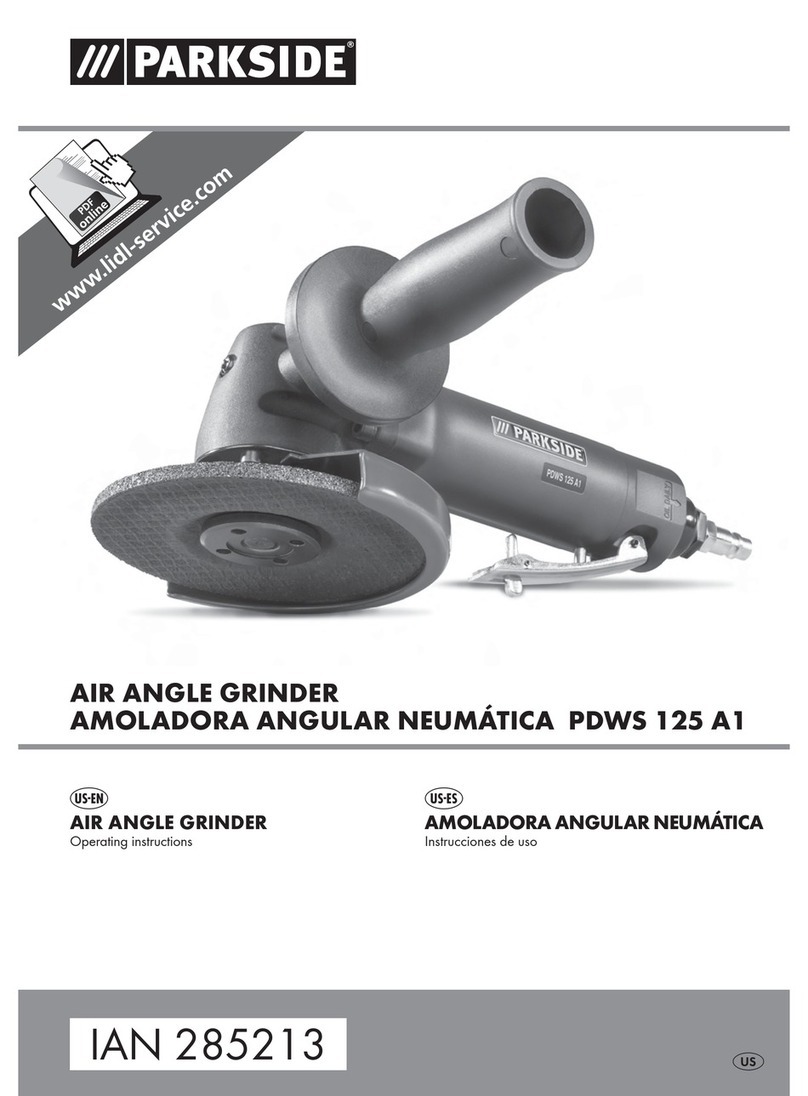
Parkside
Parkside PDWS 125 A1 operating instructions

Hilti
Hilti AG 230-27DB Original operating instructions

GEISMAR STUMEC
GEISMAR STUMEC MP.12 instruction manual
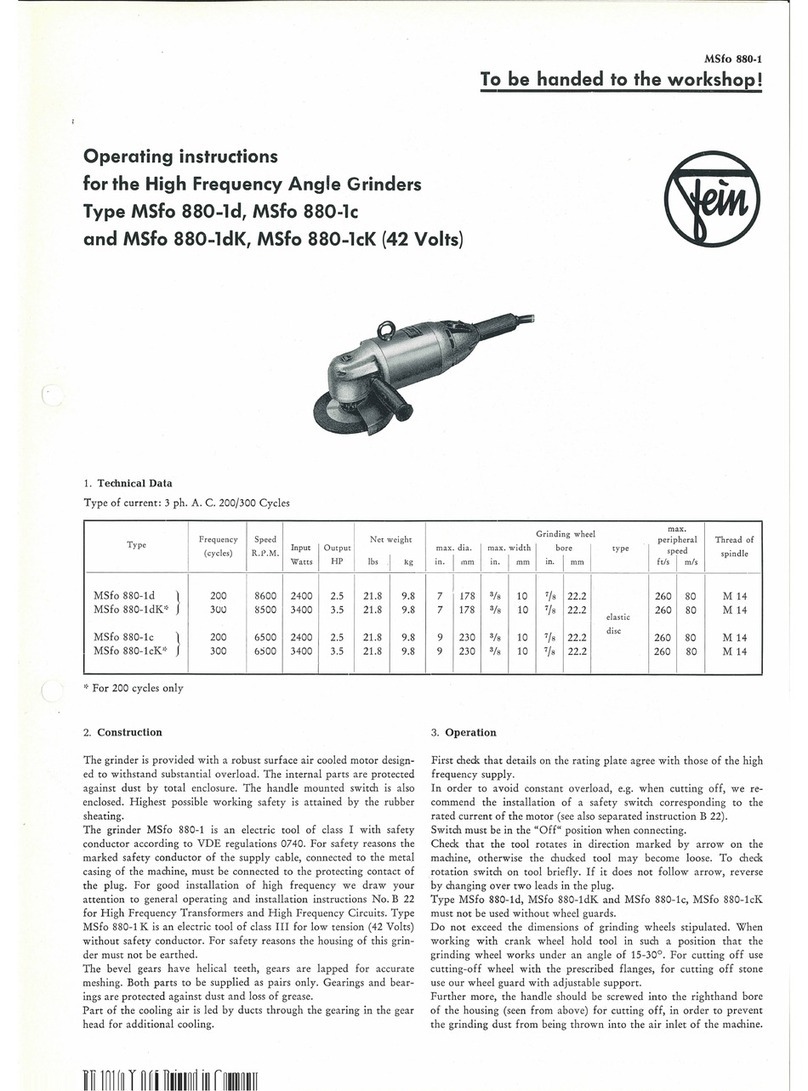
Fein
Fein MSfo 880-ld operating instructions
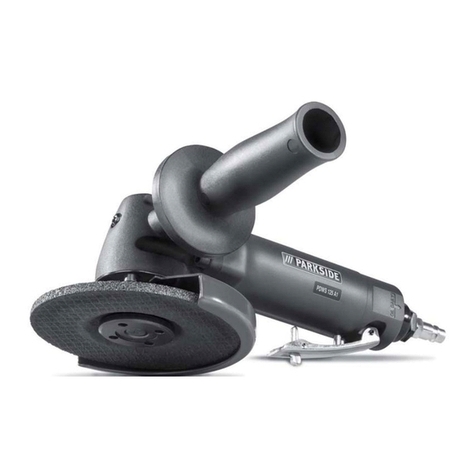
Parkside
Parkside PDWS 125 A1 operating instructions

